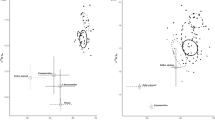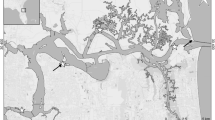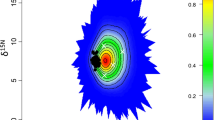Abstract
We examined the ability of three species of native North American freshwater mussels (Margaritifera margaritifera, Amblema plicata, and Pyganodon cataracta) to preferentially ingest or reject various phytoplankton species and nonliving particles. Our objective was to: (1) determine the particle preferences of the native mussels, (2) determine whether native mussels are able to differentiate between nutritious and less nutritious particles, and (3) compare sorting abilities and particle preferences to those of the invasive zebra mussel (Dreissena polymorpha). Native mussels selected and preferentially ingested the unicellular cyanobacteria Microcystis over most other phytoplankton species. However, despite their ability to select between phytoplankton, they did not select against cattail (Typha) detritus. Our results suggest that native mussels (1) prefer particles (Microcystis) that may no longer be abundant in some systems, such as the Hudson River, (2) must compete with zebra mussels for the same preferred food types (Microcystis), and (3) are unable to differentiate between nutritious (phytoplankton) and less nutritious (Typha detritus) particles. We suggest that native mussels must compete with zebra mussels for many of the same food types and are less efficient than zebra mussels at differentiating between nutritious and less nutritious particles. This indicates that there is an additional mechanism, other than direct physical interference, contributing to native mussel mortalities following zebra mussel invasions.
Similar content being viewed by others
References
Baker, S. M. & D. J. Hornbach, 1997. Acute physiological effects of zebra mussel (Dreissena polymorpha) infestation on two unionid mussels, Actinonaias ligamentina and Amblema plicata. Can. J. Fish. aquat. Sci. 54: 512–519.
Baker, S. M., J. S. Levinton, J. P. Kurdziel & S. E. Shumway, 1998. Selective feeding and biodeposition by zebra mussels and their relation to changes in phytoplankton composition and seston load. J. Shellfish Res. 17: 1207–1213.
Bastviken, D. E., N. F. Caraco & J. J. Cole, 1998. Experimental measurements of zebra mussel (Dreissena polymorpha) impacts on phytoplankton community composition. Freshwat. Biol. 39: 375–386.
Bayne, B. L., J. Widdows & R. I. E. Newell, 1977. Physiological measurements on estuarine bivalve molluscs in the field. In Keegan, B. F., P. O. Ceidigh & P. J. S. Boaden (eds), Biology of Benthic Organisms. Pergamon Press, Oxford: 57–68.
Bogan, A. E., 1993. Freshwater bivalve extinctions (Mollusca: Unionoida): a search for causes. Am. Zool. 33: 599–609.
Caraco, N. G., J. J. Cole, P. A. Raymond, D. L. Strayer, M. L. Pace, S. E. G. Findlay & D. T. Fischer, 1997. The zebra mussel invasion in a large, turbid river: phytoplankton response to increased grazing. Ecology 78: 588–602.
Cole, J. J., N. F. Caraco & B. Peierls, 1991. Phytoplankton primary production in the tidal, freshwater Hudson River, New York (USA). Verh. int. Ver. Limnol. 24: 1715–1719.
Coughlan, J., 1969. The estimation of filtering rate from clearance of suspensions. Mar. Biol. 2: 356–358.
Crosby, M. P., C. J. Langdon & R. I. E. Newell, 1989. Importance of refractory plant material to the carbon budget of the oyster Crassostrea virginica. Mar. Biol. 100: 343–352.
Fahsenstiel, G. L., G. A. Lang, T. F. Nalepa & T. H. Johengen, 1995. Effects of the zebra mussel (Dreissena polymorpha) colonization on water quality parameters in Saginaw Bay, Lake Huron. J. Great Lakes Res. 21: 435–448.
Gillis, P. L. & G. L. Mackie, 1994. Impact of the zebra mussel, Dreissena polymorpha, on populations of Unionidae (Bivalvia) in Lake St. Clair. Can. J. Zool. 72: 1260–1271.
Guillard, R. R. L., 1983. Culture of phytoplankton for feeding marine invertebrates. In Berg C. J. Jr, (ed.), Culture of Marine Invertebrates, Selected Readings. Huchison Ross Publishing, Stroudsberg: 108–132.
Guillard, R. R. L. & P. E. Hargraves, 1993. Stichochrysis immobilis is a diatom, not a chrysophyte. Phycologia 32: 234–236.
Haag, W. R., D. J. Berg & D.W. Garton, 1993. Reduced survival and fitness in native bivalves in response to fouling by the introduced zebra mussel (Dreissena polymorpha) in western Lake Erie. Can. J. Fish. aquat. Sci. 50: 13–19.
Hawkins, A. J. S., R. F. M. Smith, B. L., Bayne & M. Heral, 1996. Novel observations underlying the fast growth of suspension-feeding shellfish in turbid environments: Mytilus edulis. Mar. Ecol. Prog. Ser. 131: 179–190.
Heath, R. T., G. L. Fahnensteil, W. S. Gardner, J. F. Cavaletto & S.-J. Hwang, 1995. Ecosystem-level effects of zebra mussels (Dreissena polymorpha): a mesocosm experiment in Saginaw Bay, Lake Huron. J. Great Lakes Res. 21: 501–516.
Holland, R. E., 1993. Changes in planktonic diatoms and water transparency in Hatchery Bay, Bass Island area, western Lake Erie since the establishment of the zebra mussel. J. Great Lakes Res. 19: 717–624.
Iglesias, J. I. P., E. Navarro, P. Alvarez Jorna & I. Armentia, 1992. Feeding, particle selection and absorption in cockles Cerastoderma edule (L.) exposed to variable conditions of food concentration and quality. J. exp. mar. Biol. Ecol. 162: 177–198.
Jacobs, J., 1974. Quantitative measurement of food selection. Oecologia 14: 413–417.
Kryger, J. & H. U. Riisgård, 1988. Filtration rate capacities in 6 species of European freshwater bivalves. Oecologia 11: 34–38.
Langdon, C. J. & R. I. E. Newell, 1990. Utilization of detritus and bacteria as food sources by two bivalve suspension-feeders, the oyster Crassostrea virginica and the mussel Geukensia demissa. Mar. Ecol. Prog. Ser. 58: 299–310.
Leach, J. H., 1993. Impacts of the zebra mussel (Dreissena polymorpha) on water quality and fish spawning reefs in western Lake Erie. In Nalepa T. F. & D. W. Schloesser (eds), Zebra Mussels: Biology, Impacts, and Control. Lewis Publishers, Boca Raton: 381–397.
MacDonald, B. A. & J. E. Ward, 1994. Variation in food quality and particle selectivity in the sea scallop Placopecten magellanicus (Mollusca: Bivalvia). Mar. Ecol. Prog. Ser. 108: 251–264.
MacIsaac, H. J., 1996. Potential abiotic and biotic impacts of zebra mussels on the inland waters of North America. Am. Zool. 36: 287–299.
Mackie, G. L., 1991. Biology of the exotic zebra mussel, Dreissena polymorpha, in relation to native bivalves and its potential impact in Lake St. Clair. Hydrobiologia 219: 251–268.
Marshall, H. G., 1988. Seasonal phytoplankton composition and concentration patterns within the Hudson River. Technical Report 018/86b/011. Hudson River Foundation, New York City. 31 pp.
Nalepa, T. F., 1994. Decline of native unionid bivalves in Lake St. Clair after infestation by the zebra mussel, Dreissena polymorpha. Can. J. Fish. aquat. Sci. 51: 2227–2233.
Navarro, E. & J. I. P. Iglesias, 1993. Infaunal filter-feeding bivalves and the physiological response to short-term fluctuations in food availability and composition. In Dame R. F. (ed.), Estuarine and Coastal Ecosystem Processes. Springer-Verlag, Heidelberg. G33: 25–56.
Navarro, E., J. I. P. Iglesias, A. P. Camacho & U. Labarta, 1996. The effect of diets of phytoplankton and suspended bottom material on feeding and absorption of raft mussels (Mytilus galloprovincialis Lmk). J. exp. mar. Biol. Ecol. 198: 175–189.
Reeders, H. H., A. Bij de Vaate & F. J. Slim, 1989. The filtration rate of Dreissena polymorpha (Bivalvia) in three Dutch lakes with reference to biological water quality management. Freshwat. Biol. 22: 133–141.
Ricciardi, A., F. G. Whoriskey & J. B. Rasmussen, 1996. Impact of the Dreissena invasion on native unionid bivalves in the upper St. Lawrence River. Can. J. Fish. aquat. Sci. 53: 1434–1444.
Roditi, H. A., N. F. Caraco, J. J. Cole & D. L. Strayer, 1996. Filtration of Hudson River water by the zebra mussel (Dreissena polymorpha). Estuaries 19: 824–832.
Schloesser, D. W. & W. P. Kovalak, 1991. Infestation of unionids by Dreissena polymorpha in a power plant canal in Lake Erie. J. Shellfish Res. 10: 355–359.
Smith, T. E., R. J. Stevenson, N. F. Caraco & J. J. Cole, 1998. Changes in phytoplankton community structure during the zebra mussel (Dreissena polymorpha) invasion of the Hudson River (New York). J. Plankton Res. 20: 1567–1579.
Strayer, D. L. & L. C. Smith, 1996. Relationships between zebra mussels (Dreissena polymorpha) and unionid clams during the early stages of the zebra mussel invasion of the Hudson River. Freshwat. Biol. 36: 771–779.
Strayer, D. L., J. Powell, P. Ambrose, L. C. Smith, M. L. Pace & D. T. Fischer, 1996. Arrival, spread, and early dynamics of a zebra mussel (Dreissena polymorpha) population in the Hudson River estuary. Can. J. Fish. aquat. Sci. 53: 1143–1149.
Strayer, D. L. N. F. Caraco, J. J. Cole, S. Findlay & M. L. Pace, 1999. Transformation of freshwater ecosystems by bivalves – a case study of zebra mussels in the Hudson River. Bioscience 49: 19–27.
Vanderploeg, H. A., T. H. Johengen, J. R. Strickler, J. R. Liebig & T. F. Nalepa, 1996. Zebra mussels may be promoting Microcystis blooms in Saginaw Bay and Lake Erie. Bull. N. Am. Benthol. Soc. 13: 181–182.
Author information
Authors and Affiliations
Rights and permissions
About this article
Cite this article
Baker, S.M., Levinton, J.S. Selective feeding by three native North American freshwater mussels implies food competition with zebra mussels. Hydrobiologia 505, 97–105 (2003). https://doi.org/10.1023/B:HYDR.0000007298.52250.99
Issue Date:
DOI: https://doi.org/10.1023/B:HYDR.0000007298.52250.99




